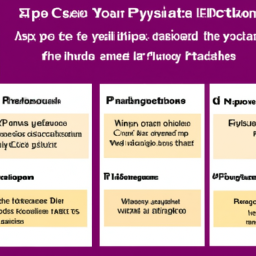Four possible ways of getting h-pylori infection

What if helicobacter pylori infection were found in my health checkup, should I get treatment?
2023-02-21
Does all h-pylori infection cause stomach cancer?
2023-02-22Four possible ways of getting h-pylori infection

Four possible ways of getting h-pylori infection
-
Table of Contents
- Introduction
- The Risk of Sharing Tableware: How H-Pylori Infection Can Spread Through Utensils and Dishes
- The Dangers of Drinking Contaminated Water: How H-Pylori Infection Can Spread Through Water Sources
- How Food Can Transmit H-Pylori Infection: Examining the Risks of Eating Contaminated Food
- Conclusion
1. “Don’t Let H-Pylori Infection Get You Down – Know the Four Ways!”
2. “Four Ways to Avoid H-Pylori Infection – Stay Informed!”
3. “Be Proactive – Know the Four Ways to Avoid H-Pylori Infection!”
4. “Protect Yourself – Learn the Four Ways to Avoid H-Pylori Infection!”
Introduction
H-pylori infection is a common bacterial infection that affects the stomach and small intestine. It is estimated that up to 50% of the world’s population is infected with H-pylori. While the infection is usually harmless, it can cause a range of digestive symptoms and can lead to more serious health problems if left untreated. Fortunately, there are several ways to reduce your risk of getting H-pylori infection. In this article, we will discuss four possible ways of getting H-pylori infection and how to reduce your risk.<h3 id=”wpaicg-the-risk-of-sharing-tableware-how-h-pylori-infection-can-spread-through-utensils-and-dishes”>The Risk of Sharing Tableware: How H-Pylori Infection Can Spread Through Utensils and Dishes
Sharing tableware can be a risk factor for the spread of H-pylori infection. H-pylori is a type of bacteria that can cause stomach ulcers and other digestive issues. It is usually spread through contact with an infected person, but it can also be spread through contaminated food and water, and even through shared utensils and dishes.
When someone with H-pylori infection uses a utensil or dish, the bacteria can be transferred to the utensil or dish. If another person then uses the same utensil or dish, they can become infected with the bacteria. This is especially true if the utensil or dish is not washed properly after use.
In addition to sharing utensils and dishes, H-pylori can also be spread through contact with an infected person’s saliva. This can happen if someone with H-pylori infection shares a drink or food with another person. It can also happen if someone with H-pylori infection kisses another person.
To reduce the risk of spreading H-pylori infection, it is important to practice good hygiene. Utensils and dishes should be washed thoroughly after each use, and hands should be washed before and after handling food. It is also important to avoid sharing food and drinks with someone who is known to have H-pylori infection.
In conclusion, sharing tableware can be a risk factor for the spread of H-pylori infection. To reduce the risk of spreading the infection, it is important to practice good hygiene and avoid sharing food and drinks with someone who is known to have H-pylori infection.<h3 id=”wpaicg-the-dangers-of-drinking-contaminated-water-how-h-pylori-infection-can-spread-through-water-sources”>The Dangers of Drinking Contaminated Water: How H-Pylori Infection Can Spread Through Water Sources
Water contamination is a serious public health concern, as it can lead to the spread of a variety of illnesses and diseases. One of the most common waterborne illnesses is H-pylori infection, which is caused by the bacteria Helicobacter pylori. This infection can be spread through contaminated water sources, and can cause a variety of symptoms, including abdominal pain, nausea, vomiting, and diarrhea.
H-pylori is a type of bacteria that is found in the stomach and intestines of humans and animals. It is usually spread through contact with contaminated food or water, or through contact with an infected person. Ingesting contaminated water can lead to H-pylori infection, as the bacteria can survive in water for up to two weeks.
The most common symptom of H-pylori infection is abdominal pain, which can range from mild to severe. Other symptoms include nausea, vomiting, loss of appetite, and diarrhea. In some cases, the infection can also cause ulcers in the stomach and intestines. If left untreated, H-pylori infection can lead to more serious complications, such as bleeding in the stomach or intestines, or even stomach cancer.
It is important to take steps to prevent H-pylori infection, as it can be spread through contaminated water sources. It is important to ensure that all drinking water is safe and free from contamination. This can be done by boiling water for at least one minute before drinking it, or by using a water filter. It is also important to practice good hygiene, such as washing hands regularly and avoiding contact with people who may be infected.
In conclusion, H-pylori infection is a serious health concern that can be spread through contaminated water sources. It is important to take steps to prevent the spread of this infection, such as boiling water before drinking it and practicing good hygiene. If you experience any of the symptoms of H-pylori infection, it is important to seek medical attention as soon as possible.<h3 id=”wpaicg-how-food-can-transmit-h-pylori-infection-examining-the-risks-of-eating-contaminated-food“>How Food Can Transmit H-Pylori Infection: Examining the Risks of Eating Contaminated Food
Food can be a major source of transmission for the bacteria Helicobacter pylori (H-pylori). This bacteria is a common cause of stomach ulcers and can lead to serious health complications if left untreated. It is important to understand the risks associated with eating contaminated food in order to reduce the chances of infection.
H-pylori is a type of bacteria that lives in the stomach and can cause inflammation and ulcers. It is usually spread through contact with an infected person, such as through saliva or vomit. However, it can also be transmitted through contaminated food. This can occur when food is prepared or handled by someone who is infected with the bacteria.
Foods that are most likely to be contaminated with H-pylori include raw or undercooked meats, poultry, and seafood. These foods can become contaminated if they are handled by someone who is infected with the bacteria. Additionally, foods that are not cooked properly can also become contaminated if they are stored or prepared in an environment that is contaminated with the bacteria.
The risk of infection from contaminated food can be reduced by following proper food safety guidelines. This includes washing hands thoroughly before and after handling food, cooking food to the proper temperature, and storing food at the correct temperature. Additionally, it is important to avoid cross-contamination by using separate cutting boards and utensils for raw and cooked foods.
It is also important to be aware of the symptoms of H-pylori infection. These include abdominal pain, nausea, vomiting, and loss of appetite. If you experience any of these symptoms, it is important to seek medical attention as soon as possible.
In conclusion, food can be a major source of transmission for H-pylori. It is important to understand the risks associated with eating contaminated food in order to reduce the chances of infection. Following proper food safety guidelines and being aware of the symptoms of H-pylori infection can help to reduce the risk of infection.
Conclusion
In conclusion, H-pylori infection can be acquired in a variety of ways, including through contaminated food and water, contact with an infected person, and even through contact with contaminated surfaces. It is important to take precautions to avoid coming into contact with any of these sources of infection, as H-pylori can cause serious health complications if left untreated.
If you think you may have been exposed to H-pylori infection, don’t wait to get tested! There are four possible ways of getting H-pylori infection, so it’s important to get tested as soon as possible. Visit eTestMedical.com to learn more about H-pylori testing and to find a testing center near you. Don’t wait – get tested today!



